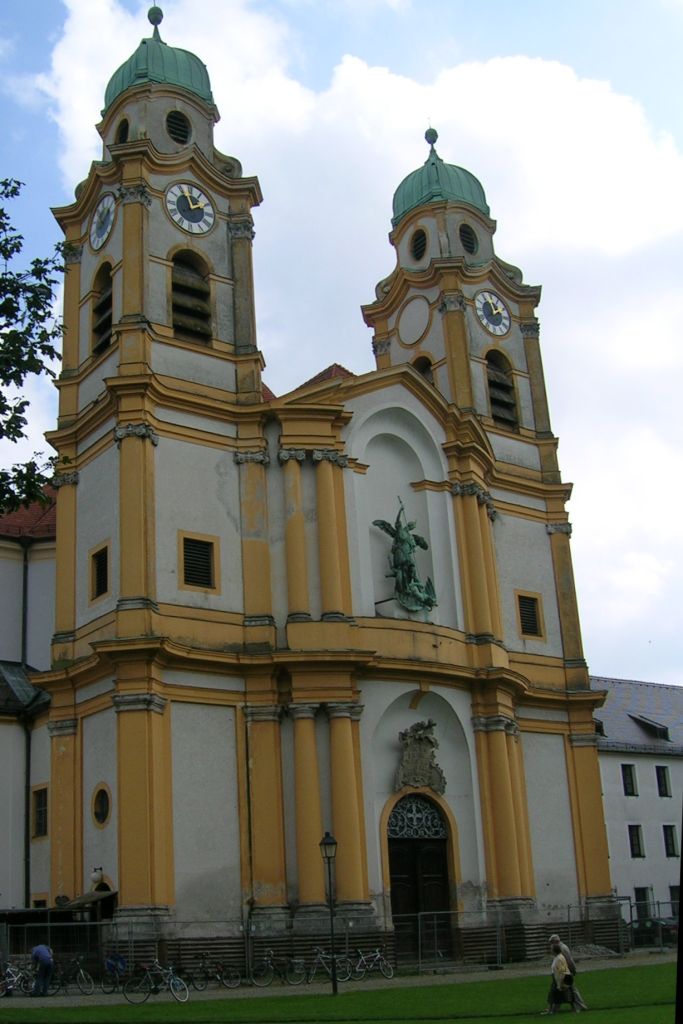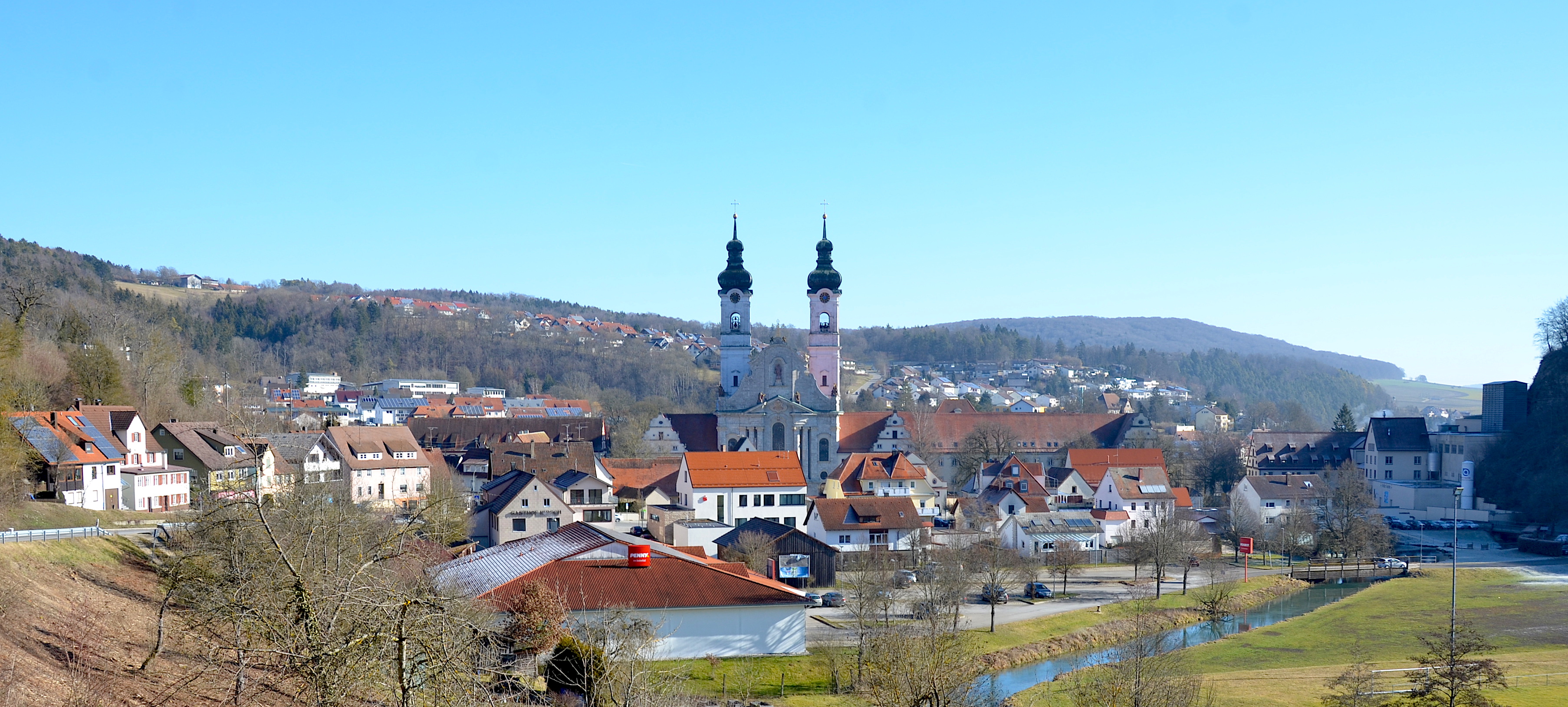|
Johann Michael Fischer
Johann Michael Fischer (18 February 1692 – 6 May 1766) was a German architect in the late Baroque period. Fischer was born in Burglengenfeld, Upper Palatinate. He is a major representative of south German Baroque architects. He studied in Bohemia and combined Bohemian elements with Bavarian Baroque traditions. He often co-operated with the most gifted Bavarian artists of his time, such as Cosmas Damian Asam and Egid Quirin Asam, Johann Joseph Christian, Johann Michael Feuchtmayer, Matthäus Günther, Ignaz Günther, Franz Joseph Spiegler, Johann Baptist Straub, and Johann Baptist Zimmermann. Fischer died, aged 74, in Munich, and is buried in the Munich Frauenkirche. Main Works Fischer designed 32 churches and 23 monasteries in southern Germany. Among these, the best-known are the following. Bavaria * Aufhausen— Pilgrimage Church of Maria Schnee (1736–1751) *Benediktbeuern—Anastasia Chapel in the Church of St. Benedikt (1750–1758), considered ... [...More Info...] [...Related Items...] OR: [Wikipedia] [Google] [Baidu] |
Johann Baptist Straub
Johann Baptist Straub (1 June 1704 (baptism) – 15 July 1784) was a German Rococo sculptor. Biography Straub was born in Wiesensteig, into a family of sculptors. His father Johann George Straub and his brothers Philipp Jakob, Joseph, and Johann Georg Straub were also sculptors, as was his nephew Franz Xaver Messerschmidt. J. B. Straub studied in Munich with the court sculptor Gabriel Luidl and then went to Vienna, where he worked from 1726 to 1734. In 1734 Straub returned to Munich. In 1737 he was appointed by Elector Karl Albrecht from Bavaria as the court sculptor. In the same year Straub married a daughter of the court engraver, Franz Xaver Späth. Straub worked primarily in Upper Bavarian churches and monasteries, frequently alongside some of the greatest Baroque artists of the day: the architect Johann Michael Fischer, the painter Johann Baptist Zimmermann, the Asam Brothers, the Tyrolian painter Johann Jacob Zeiller, and the stuccoists Franz Xaver and Johann ... [...More Info...] [...Related Items...] OR: [Wikipedia] [Google] [Baidu] |
St Michael In Berg Am Laim (München)
St Michael in Berg am Laim is a church in Munich, Bavaria, built from 1738 to 1751 by Johann Michael Fischer as Court Church for Elector and Archbishop Clemens August of Cologne, a brother of Emperor Charles. Clemens August owned Berg am Laim as a manor. It was also served by the Military Order of Saint Michael until 1837 and by the ''Archbrotherhood of Saint Michael''until today. The Catholic church is one of the chief works of the Bavarian rococo period. Architecture The elegant façade with its twin towers provides a strong vertical accent was designed as the terminal feature of a street to the inner city which was never built. It is the only church of Fischer which was decorated in the rococo style with rich rocaille, maybe this was due to François de Cuvilliés the Elder, who served as a building inspector for this church. Large round-headed arches divide the interior of the church in different sections. The central space is decorated by pilasters and columns and the c ... [...More Info...] [...Related Items...] OR: [Wikipedia] [Google] [Baidu] |
Abbey Church Of St
An abbey is a type of monastery used by members of a religious order under the governance of an abbot or abbess. Abbeys provide a complex of buildings and land for religious activities, work, and housing of Christian monks and nuns. The concept of the abbey has developed over many centuries from the early monastic ways of religious men and women where they would live isolated from the lay community about them. Religious life in an abbey may be monastic. An abbey may be the home of an enclosed religious order or may be open to visitors. The layout of the church and associated buildings of an abbey often follows a set plan determined by the founding religious order. Abbeys are often self-sufficient while using any abundance of produce or skill to provide care to the poor and needy, refuge to the persecuted, or education to the young. Some abbeys offer accommodation to people who are seeking spiritual retreat. There are many famous abbeys across the Mediterranean Basin and Europe ... [...More Info...] [...Related Items...] OR: [Wikipedia] [Google] [Baidu] |
Fürstenzell
Fürstenzell ( bar, label=Central Bavarian, Fiaschtnzei) is a municipality in the district of Passau in Bavaria in Germany Germany,, officially the Federal Republic of Germany, is a country in Central Europe. It is the second most populous country in Europe after Russia, and the most populous member state of the European Union. Germany is situated betwe .... References Passau (district) {{Passaudistrict-geo-stub ... [...More Info...] [...Related Items...] OR: [Wikipedia] [Google] [Baidu] |
Dießen Am Ammersee
Dießen am Ammersee (Southern Bavarian: ''Diaßn am Ammasä'') is a municipality in the district of Landsberg in Bavaria in Germany. It is located on the shores of the Ammersee. Geography Situated in the Bavarian Alpine Foreland the town stretches from the shores of the Ammersee to the forested morainic hills of the Saale and Würm glaciation. The town area consists of the market town of Dießen (with St. Georgen, Wengen, Ziegelstadel, Bischofsried and Seehof) and the former independent boroughs of Rieden (with Riederau, Bierdorf, Lachen, St. Alban and Romenthal), Dettenschwang (with Oberhausen, Unterhausen, Wolfgrub and Abtsried), Dettenhofen (with Pitzeshofen, Engenried, Hübschenried and Ummenhausen) and Obermühlhausen (with Oberbeuern, Unterbeuern and Schlöglhof). History In Roman times the Via Raetia passed through the area of the modern town. The first documentary mention of the village "Diezen" dates from 1039, the name meaning waterfall. From 1050 on a local nob ... [...More Info...] [...Related Items...] OR: [Wikipedia] [Google] [Baidu] |
Benediktbeuern Abbey
Benediktbeuern Abbey (Kloster Benediktbeuern) is an institute of the Salesians of Don Bosco, originally a monastery of the Benedictine Order, in Benediktbeuern in Bavaria, near the Kochelsee, 64 km south-south-west of Munich. It is the oldest and one of the most beautiful monasteries in Upper Bavaria. First Benedictine foundation The monastery, dedicated to Saints James and Benedict, was founded in around 739/740 as a Benedictine abbey by members of the Huosi, a Bavarian noble clan, who also provided the three brothers who served one after the other as the first three abbots, traditionally named as Lanfrid, Waldram (or Wulfram), and Eliland, for nearly a century. It is possible that Saint Boniface had an involvement in the foundation; he may have consecrated the church (to the holy Trinity), though this is not widely accepted. There was here a school of writing, whose work survives in the form of numerous codices of the 8th and 9th centuries. In 955 the monastery was destroye ... [...More Info...] [...Related Items...] OR: [Wikipedia] [Google] [Baidu] |
Benediktbeuern
Benediktbeuern (Central Bavarian: ''Benediktbeiern'') is a municipality in the district of Bad Tölz-Wolfratshausen in Bavaria, Germany, 2 kilometers, or 1.25 miles from Bichl. The village has 3,602 residents as of 31 December 2019. The medieval Latin name of Benediktbeuern was ''Buria'' (adjective: ''Burana'').SeOrbis Latinus/ref> Benediktbeuern has a famous monastery, formerly belonging to the Benedictine Order, called Benediktbeuern Abbey, which was founded in about 739. Its name is well known because of the ''Carmina Burana'' ('Benediktbeuern songs') manuscript found there in 1803 and subsequently set to music by Carl Orff. Since 1930 the Salesians of Don Bosco have lived in this monastery. Johann Wolfgang von Goethe visited Benediktbeuern during his third journey to Italy in 1786. The secular village itself - its ribbon-development clearly distinct from the abbey's edifices - was called Laingruben until 30 November 1865, when it was permitted to take the name of the monas ... [...More Info...] [...Related Items...] OR: [Wikipedia] [Google] [Baidu] |
Aufhausen Priory
Aufhausen Priory (german: Kloster Aufhausen), formerly the Aufhausen Oratory, is a Benedictine monastery located at Aufhausen near Regensburg in Bavaria, Germany. The original community, dedicated to Our Lady of the Snows, was founded in the late 17th century as an Oratorian community by the local priest, Johann Georg Seidenbusch. It was not dissolved during the secularisation of Bavaria in 1802–03, but remained under the title "Königliches Nerianerinstitut" (''Royal Nerian Institute''), at least until 1829. The last provost died in 1886. It was re-settled in 1890 from the Benedictine abbey at Metten Metten is a municipality in the district of Deggendorf in Bavaria in Germany. The town grew up around the Benedictine Metten Abbey, founded in 766. Metten is also the birthplace of former Bayern Munich Fußball-Club Bayern Münch ..., and partly re-built. References External links Monasteries in Bavaria Benedictine monasteries in Germany Oratorian ... [...More Info...] [...Related Items...] OR: [Wikipedia] [Google] [Baidu] |
Aufhausen
Aufhausen is a municipality in the district of Regensburg in Bavaria in Germany Germany, officially the Federal Republic of Germany (FRG),, is a country in Central Europe. It is the most populous member state of the European Union. Germany lies between the Baltic and North Sea to the north and the Alps to the sou .... Aufhausen Priory is located in the village. Notable people * Johann Georg Seidenbusch (1641–1729), priest, painter, and composer, founder of Aufhausen Priory References Regensburg (district) {{Regensburgdistrict-geo-stub ... [...More Info...] [...Related Items...] OR: [Wikipedia] [Google] [Baidu] |
Zwiefalten Abtei
Zwiefalten is a municipality in the district of Reutlingen, Baden-Württemberg, Germany located halfway between Stuttgart and Lake Constance. The former Zwiefalten Abbey dominates the town. The former monastery is considered one of the finest examples of late Baroque art. Geographical location The name derives from its location in the valleys of Zwiefalter Aach and the Kessel-Aach and was mentioned first as Zwivaltum in 904. Neighboring communities The following cities and towns are bordering to the municipality of Zwiefalten (listed clockwise from the north) and belong to the district of Reutlingen and the Alb-Donau-district¹ and district Biberach²: Hayingen, Emeringen¹, Riedlingen², Langenenslingen² and Pfronstetten. Municipality arrangement The municipality Zwiefalten with the municipality parts Baach, Gauingen, Gossenzungen, Hochberg, Mörsingen, Sonderbuch, and Upflamör Zwiefalten include a total of seven villages, one hamlet (Attenhöfen) and three yards (Loretto, B� ... [...More Info...] [...Related Items...] OR: [Wikipedia] [Google] [Baidu] |
Ottobeuren Basilika Fassade
Ottobeuren ( Swabian: ''Ottobeire'', Medieval Latin: ''Ottobura'') is a market town and municipality in Bavaria, Germany, located 11 km southeast of Memmingen near the A7. It is famous for Ottobeuren Abbey, situated next to the Basilica. The town is seat of a municipal association with Hawangen and Böhen. The musicologist Manfred Hermann Schmid was born in Ottobeuren. Twin towns — sister cities Ottobeuren is twinned with: * Norcia, Italy * Saint-Donat-sur-l'Herbasse, France * Tenterfield, New South Wales Tenterfield is a regional town in New South Wales, Australia. At the , Tenterfield had a population of 4,066. Tenterfield's proximity to many regional centres and its position on the route between Sydney and Brisbane led to its development as a ..., Australia References Unterallgäu {{Unterallgäu-geo-stub ... [...More Info...] [...Related Items...] OR: [Wikipedia] [Google] [Baidu] |





